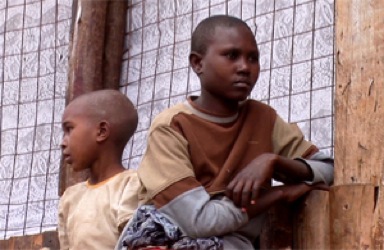
These Are Our Children is a one-hour documentary film that reveals how the devastating effects of poverty, HIV/AIDs, and violence on Kenyan children are successfully being reduced through local grassroots interventions.
Known for its exquisite natural beauty and safari adventures, Kenya has recently experienced violent conflicts, poverty, famine, and disease, putting millions of Kenyans at risk. Kenya’s children are especially susceptible to the effects of these adversities because they often face them alone. More than one million children in Kenya have been affected by the HIV-AIDs crisis. Many are taking care of sick parents and siblings; thousands more are living with the virus themselves. These children have also had to deal with recent episodes of violent national conflicts: in 2006 inter-ethnic and gang violence resulted in the brutal deaths of thousands. The post-election violence of 2008 involved mass killings and the displacement of thousands of families from their homes into hastily erected camps, where many still live. And over 300,000 children live on the streets, stealing, begging, and prostituting themselves for food and money.
The physical effects of disease and violence are apparent to those wanting to help rebuild these young lives, but the psychological affects to these children’s minds and hearts go largely unnoticed and unfortunately, unaddressed.
The infamous settlements of Nairobi are home to millions of people living in tin and cardboard shacks that lack sewer systems and running water. Children sleep on cardboard covered by plastic bags. If they’re lucky, they can earn the equivalent of thirty cents through begging, doing dirty and dangerous work for street vendors that will allow them to eat once a day. If they’re very lucky, they won’t be beaten, raped, or killed. But in the midst of this poverty, teachers, parents, volunteers, and community organizers work for nothing, or a small stipend to bring education and emotional support to the children of their communities. The teachers at Valley View Academy, a private school that serves students who live in the Mathare settlement, work from 6:00 am to 6:00 pm for a stipend that barely pays their rent. In addition to administering the traditional academic curriculum, they direct afterschool programs to keep children of the streets and away from the dangers of the drug and alcohol trade as well as prostitution. St. Elizabeth’s Academy in the Dandura settlement and the Jovial Community Education Center located in the Mukuru settlement provide a second home and a place of safety for children who are orphans or live in single-parent households where ten or more people share two rooms. Joy Divine, run by Pastor Mary and her son Fred, is home to more than thirty boys and young men who once roamed the streets sniffing glue and searching through piles of garbage for food. More than 150 children between the ages of four and eighteen live at the Children’s Empowerment Centre in Thunguma. Some were dropped off at the front gate by a parent who couldn’t care for their child; others were rescued from the street or from government social halls where orphans and street children are taken after been picked up by the police.
These Are Our Children does not ignore the overwhelming problems Kenyan children face on a daily basis. Yet, through hope and hard work, we learn from the children and the adults they work with that schools and grass-root organizations are creating a future in which all children can realize their dreams to be teachers, pilots, doctors, generals, and world-famous soccer players.



